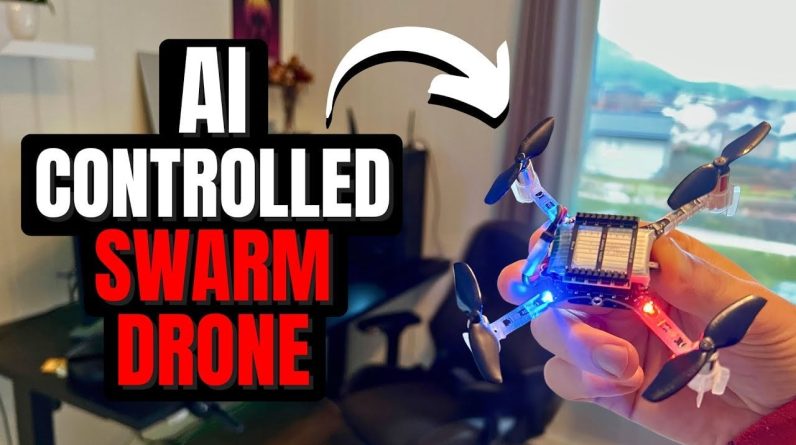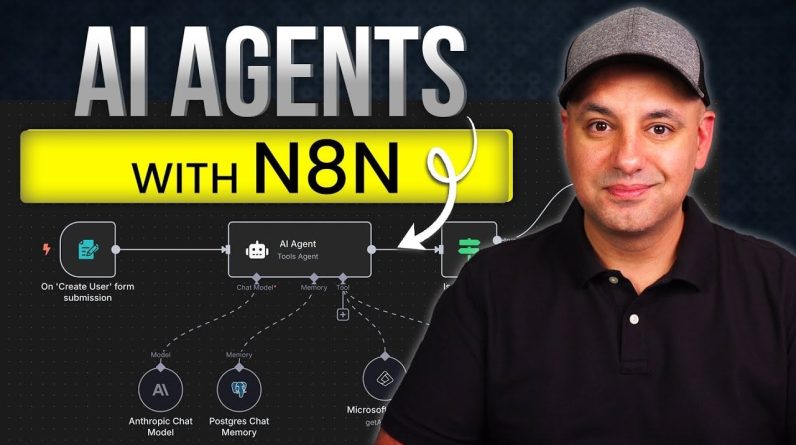
What if the future of robotics wasn’t a single machine but an intelligent swarm, moving as one, adapting to its environment, and executing tasks with precision? Imagine a fleet of drones navigating a disaster zone, autonomously coordinating to locate survivors, or monitoring vast agricultural fields with unparalleled efficiency. This isn’t science fiction, it’s the reality being shaped by AI-powered swarm drones, a fusion of innovative robotics and artificial intelligence. But as thrilling as this innovation sounds, it also raises questions: How do we program such complex systems? What happens when they malfunction? And perhaps most importantly, are we ready for the ethical and security challenges they bring? The answers lie in the intricate process of building, testing, and understanding these remarkable machines.
In this exploration, All About AI uncover the fascinating mechanics behind creating an AI swarm drone, from assembling the hardware to programming autonomous behaviors like voice-controlled flight and object detection. You’ll also gain insight into the challenges, like sensor limitations and environmental unpredictability, that make this field as daunting as it is exciting. Whether you’re intrigued by the potential for swarm coordination in search-and-rescue missions or curious about the role generative AI plays in simplifying drone programming, this journey promises to reveal both the promise and the perils of this emerging technology. And as you’ll see, the line between “scary” and “cool” is often thinner than we think.
AI-Powered Swarm Drones
TL;DR Key Takeaways :
- The development of AI-powered swarm drones combines generative AI, Python programming, and advanced drone components to enable autonomous flight, voice recognition, and object detection.
- Key hardware components include the Crazyflie 2.1 drone platform, flow deck sensors for height detection, motors, propellers, and a battery pack, making sure structural and functional capabilities.
- Generative AI simplifies programming tasks, allowing advanced autonomous behaviors like figure-eight flight patterns, swarm coordination, and obstacle avoidance.
- Voice recognition using OpenAI’s Whisper API enhances usability by allowing hands-free operation through real-time voice commands, improving efficiency and accessibility.
- Challenges such as environmental factors, sensor limitations, and object detection accuracy remain, but future advancements in swarm coordination and AI integration promise fantastic applications in fields like disaster response, agriculture, and industrial inspections.
Drone Assembly: Establishing the Foundation
The foundation of any AI-powered drone lies in its hardware assembly. For this project, the Crazyflie 2.1 drone serves as the base platform due to its compact size and modular design. The essential components required for assembly include:
- A flow deck sensor for height detection and environmental awareness
- Motors and propellers to provide propulsion and stability
- A battery pack to supply power
- A radio controller for communication and manual operation
The assembly process begins with attaching the motors and propellers to the drone’s frame, making sure they are securely fastened to maintain stability during flight. Next, the flow deck sensor is installed to enable height detection, followed by the connection of the battery pack to power the system. These components work together to provide the drone with the necessary structural and functional capabilities.
Before integrating AI functionalities, it is crucial to test the drone’s basic hardware. Using a PlayStation controller or a similar device, you can manually verify that the motors and propellers are functioning correctly. This initial testing phase ensures that the hardware is operational and ready for programming, reducing the risk of complications during later stages.
Programming the Drone: Simplifying with Generative AI
Programming is the stage where the drone transitions from a basic flying machine to an intelligent system. Python, a widely-used programming language in robotics, plays a central role in this process. Generative AI tools can assist in creating Python scripts for fundamental flight operations, such as hovering, landing, and executing simple maneuvers. These tools simplify the coding process, allowing you to focus on refining the drone’s capabilities.
Once the drone achieves basic flight functionality, you can program more advanced autonomous behaviors. For example, you might code the drone to perform figure-eight flight patterns or maintain a steady hover in response to environmental inputs. These advanced maneuvers demonstrate the precision and adaptability that AI can bring to drone operations, laying the groundwork for more complex tasks such as swarm coordination or obstacle avoidance.
Building and Testing an AI Swarm Drone
Expand your understanding of drones with additional resources from our extensive library of articles.
Voice Control: Enhancing Usability with Speech Recognition
Integrating voice recognition capabilities improves the drone’s usability by allowing hands-free operation. Using OpenAI’s Whisper API, you can implement speech-to-text conversion, allowing the drone to interpret and respond to voice commands. Commands such as “move forward,” “turn left,” or “hover” can be translated into real-time actions, providing a seamless and intuitive user experience.
This feature is particularly beneficial in scenarios where multitasking is required or when coordinating multiple drones simultaneously. Voice control not only simplifies interaction but also demonstrates how AI can enhance operational efficiency and accessibility. By allowing natural language communication, the drone becomes a more versatile tool for both recreational and professional applications.
Object Detection and Autonomous Landing
Object detection is a critical capability for AI-powered drones, particularly for tasks like autonomous landing. The flow deck sensor plays a key role in this process by scanning the environment to identify height variations and locate suitable landing spots. The drone can perform a grid search to detect elevated objects or flat surfaces, making sure a safe and precise landing.
To further enhance accuracy, OpenAI’s large language models (LLMs) can be employed for real-time data analysis. These models process sensor inputs and refine the drone’s decision-making, allowing it to adapt to dynamic environments. While this technology is still evolving, it highlights the potential of AI to improve situational awareness and operational precision, making drones more reliable for complex tasks.
Challenges and Future Directions
Despite the impressive capabilities of AI-powered swarm drones, several challenges remain. Key issues include:
- Environmental factors, such as lighting conditions and surface textures, which can affect sensor performance
- Limitations in object detection accuracy, particularly in cluttered or dynamic environments
- The need for additional features, such as cameras and bounding box detection, to enhance functionality
Looking to the future, swarm coordination represents a promising area of development. By programming multiple drones to work together, you can unlock a wide range of applications, including:
- Search-and-rescue missions in disaster-stricken areas
- Agricultural monitoring to optimize crop management and yield
- Industrial inspections of large-scale infrastructure, such as bridges or pipelines
These advancements illustrate the potential of combining AI with robotics to address complex challenges across various industries. As technology continues to evolve, the integration of AI-powered drones into everyday operations is likely to expand, offering innovative solutions to pressing problems.
Exploring the Potential of AI-Powered Drones
The process of building and testing an AI-powered swarm drone showcases the remarkable possibilities of integrating artificial intelligence with robotics. From autonomous flight and voice recognition to object detection and swarm coordination, these drones exemplify the practical applications of AI in solving real-world challenges. While obstacles such as environmental limitations and sensor accuracy remain, ongoing advancements in AI and robotics promise to overcome these hurdles, paving the way for more sophisticated and reliable systems.
As of November 2025, the fusion of AI and drones continues to drive innovation across diverse fields, from agriculture and disaster response to industrial inspections and beyond. By embracing these technologies, you can contribute to shaping a future where intelligent machines enhance efficiency, safety, and productivity in unprecedented ways.
Media Credit: All About AI
Filed Under: AI, DIY Projects, Guides
Latest Geeky Gadgets Deals
If you buy something through one of these links, Geeky Gadgets may earn an affiliate commission. Learn about our Disclosure Policy.
Originally Appeared Here








